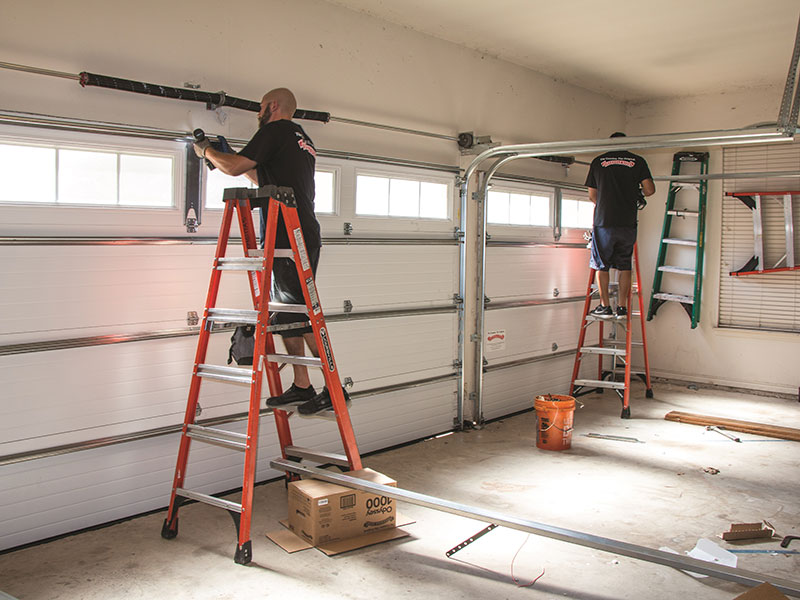Usual Garage Door Troubles and Exactly How to Repair Them
Garage doors are essential for both security and benefit, yet they frequently present a selection of common problems that can irritate house owners. While some concerns may appear straightforward to solve, others might require a more nuanced understanding of garage door technicians.
Noisy Garage Door Procedure
A noisy garage door operation can be a substantial source of annoyance for home owners, commonly showing underlying mechanical issues. Such disturbances might originate from numerous reasons, consisting of worn-out rollers, loose hardware, or not enough lubrication. Determining the resource of the noise is vital for efficient resolution.
Over time, these parts can wear away, leading to grinding or squeaking sounds as the door actions. In addition, loose screws or screws in the door system can create rattling audios throughout procedure.
An additional contributing aspect is poor lubrication of the door's moving parts. Using a top notch lubricating substance to the tracks, springs, and rollers can considerably lessen rubbing and noise. Property owners must perform this upkeep periodically to keep optimum performance.
Lastly, the garage door opener might also generate noise as a result of its age or mechanical problems. If the sound continues in spite of attending to other aspects, getting in touch with an expert for a complete examination and possible repair may be necessary.
Door Won't Open or Shut
Experiencing a garage door that will not open up or close can be incredibly irritating and usually signifies a breakdown within the system. A number of elements can contribute to this issue, and identifying the source is important for effective resolution.

Following, evaluate the safety and security sensing units situated at the base of the door. These sensors can come to be misaligned or obstructed by debris, avoiding the door from operating correctly. Clean the sensing units with a soft towel and guarantee they are straightened.
Additionally, the garage door's internal elements should be evaluated. Problems such as a broken springtime, worn-out rollers, or a harmed opener can impede motion. If any kind of components seem harmed, it may be a good idea to get in touch with an expert for repair work.
Misaligned Tracks
(Excellence Guaranteed)Misaligned tracks can badly disrupt the smooth procedure of a garage door, resulting in operational failings such as irregular movement or complete immobilization. This issue commonly develops due to a selection of aspects, consisting of damage, unintended influences, or improper installation. When the tracks are misaligned, the rollers can not move easily, which not only additional info strains the electric motor but likewise postures security dangers.
If you see any disparities, it is important to attend to the concern immediately. Thoroughly tap the track back right into its appropriate setting utilizing a rubber club or a similar tool, guaranteeing it is straight and degree.
Normal maintenance, including cleaning up the tracks and ensuring rollers are in great problem, can stop future imbalances. By addressing misaligned tracks without delay, you can recover the capability of your garage door and enhance its longevity.
Broken Springs
Amongst the different elements of a garage door system, damaged springtimes are among the most usual problems that can significantly hinder its capability. Garage door springs are essential for stabilizing the weight of the door, enabling smooth opening and closing. When a springtime breaks, it can bring about a door that is tough to operate or, in some instances, totally unusable.
There are 2 major kinds of springtimes: torsion springs, which are placed above the door, and extension springtimes, found on either side. Indications of a damaged springtime consist of a door that won't open, a noticeable void in the springtime, or a loud noise during operation. Attempting to operate a garage door with a busted spring can cause further damages to the door or the opener.
Repairing damaged springs is not a DIY task; it needs specialized tools and proficiency because of the high tension involved. It is recommended to speak with a specialist technician that can securely change the springtimes and ensure the door is appropriately balanced. Regular maintenance and evaluations can aid stop springtime failures and extend the lifespan of the garage door system.
Remote Issues

If the remote still fails to run, evaluate the garage door opener to ensure that its sensors are clean and unobstructed. Dust, debris, or misalignment might prevent the signal transmission between the remote and the opener.
Disturbance from various other digital tools can also hinder remote functionality. Ensure that nearby gadgets, such as cordless routers or cordless phones, are not triggering disturbances. garage door service. If interference is thought, attempt moving these devices further far from the garage door opener
In many cases, the remote may require to be reprogrammed. Seek advice from the manufacturer's standards to reset the remote and synchronize it with the garage door opener. If all else fails and the remote remains to malfunction, consider speaking with a specialist service technician for an extensive inspection and potential substitute of the remote or opener.
Conclusion
(Effortless Process)In summary, usual garage door troubles can substantially impact capability and security. Resolving loud operation entails lubrication and tightening equipment, while concerns with opening or closing need assessment of power sources and sensing units. Misaligned tracks can be remedied with modification, although busted springtimes demand professional treatment. Push-button control malfunctions commonly occur from weak batteries or interference, which can be fixed with replacement or reprogramming. Aggressive maintenance and prompt repair work can ensure optimal performance and long life of garage doors.